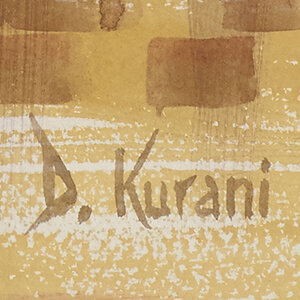


Last updated on Wed 28 March, 2018
DAVID KURANI: Reality, Composed
March 28 - September 1 2018
AUB Art Galleries, Rose and Shaheen Saleeby Museum, Sidani Street, Hamra
Curated by Katharine Gordon and Lama El Khatib(Art History Bachelor’s Students, Class of 2018, AUB)
In commemoration of his fifty years of service to the American University of Beirut, AUB Art Galleries and Collections is exhibiting the body of work of David Kurani (b. 1944), produced over the course of his career. Kurani has taken on diverse roles throughout his career at AUB: art student, practicing artist, art educator, set and costume designer, and stage director. This exhibition will trace the interweaving relations between Kurani’s artistic and educational paths, connecting his work with key moments in the history of AUB and Lebanon.
Kurani’s influence on the FAAH Department encompasses generations of students and professors. His years of dedication and service have been a major factor in the continuation of the department as it is today. As a young boy, and later a student at AUB, he was involved with the arts. From 1956, he participated in the first art seminars for children run by Maryette Charlton (1924-2013) who, along with such figures as John Carswell (b. 1931), Arthur Frick (b. 1923), and Tracy Montminy (1911-1992), would later become known as the primary actors behind the creation and continuity of a Fine Arts and Art History department at AUB.
Kurani’s experience with stage design was also a vital component of his work throughout his artistic and pedagogical career. In 1966, he enrolled in the Bristol Old Vic Theatre School (1966-68) where he concentrated on acting and directing, and found opportunities to relate his fine arts background and passion with various theatrical activities: stage design, acting and costuming. Upon his return to Lebanon in 1968, Kurani was able to weave the multiple threads of interest together, teaching both art and theatre at AUB alongside his former teachers, Frick and Carswell, as well as Helen Khal (1923-2009), encouraging young artists whilst continuing his own practice.
To engage with Kurani’s body of work, it is important to locate it within broader tendencies, both in the context of different and often opposing aesthetic positions on campus as well as in relation to the entire landscape of Lebanese art before, during, and after the Civil War. During his early university years, Kurani witnessed the formation of what could be delineated as two opposing, aesthetic camps within the department. On one end, John Carswell spearheaded a modernist tendency, one that turned its back on clear, established categories of fine arts (understood in separation as painting, sculpture, graphic arts) to rather produce art as “intermedial object,” or Art with capital “A” that questions its own condition of possibility. His solid monochromatic objects were constructed at the intersection of art and architecture, and stylistically in dialogue with minimalism and primary structures – new tendencies that were emerging around the time in response to post - WWII late or high modernism. On the other end, Arthur Frick carried on the lineage of a tradition that can be loosely defined in terms of a mimetic naturalism, which focused on realist depiction of spaces and people. Kurani’s work can be generally viewed within this framework upheld by Frick, as a continuation of a lineage that outlives the dichotomies from which it arose, generating a lasting impact on people and institutions.
Kurani’s landscapes, (painted live or from photographs) project his fascination with representing the site in remarkable detail, whether in watercolor, oil, or ink. His portraits, that have served as staples on the campuses of AUB and other institutions, portray his urge to capture the subject’s “likeness.” And while Kurani sometimes introduces expressive gestures, either through an enhancement of color or the insertion of a whimsical figure, his paintings conjure a carefully composed, illusory world perhaps best understood through the category of mimesis. At certain moments throughout his career, Kurani presented occurrences of engagement with modernist inclinations; canvases of abstract paint drips as well as experimentation with abstract forms, shapes, and figures. While these instances appear as to complicate Kurani’s position within the Lebanese history of art, revealing its intricacies, the bulk of his work asserts his full allegiance to, and belief in the representational function of art.
Through this lens of pictorial representation, Kurani’s relationship to theatre and painting begins to sharpen his comprehensive definition of art. Theatre and painting appear as companions that serve a similar function; whether painting his own sets, or framing his paintings as theatrical ‘stills’, each with their own unique narrative, Kurani consistently oscillates between theatre and painting to satisfy his urge and desire to find, within art, a medium capable of capturing and carefully composing reality.
This exhibition engages with these dual passions, theatre and painting, which have run in parallel throughout Kurani’s life. Rather than exhibiting them as a binary, the exhibition will highlight how the two activities merge and interplay in Kurani’s oeuvre. Tracing these moments, the exhibition will attempt to capture the impact that Kurani’s contributions has had at AUB, and celebrate his dedication to the institutions and figures he has encountered at AUB and abroad. Simultaneously, the exhibition will highlight his most accomplished works while attempting to both question and understand his passion for composing reality within the broader context of Lebanese modern art. The gallery space presents watercolors, set designs, posters and drawings displayed in accordance with the thematic organization of the show.
Join us in our endless discovery of modern and contemporary Arab art